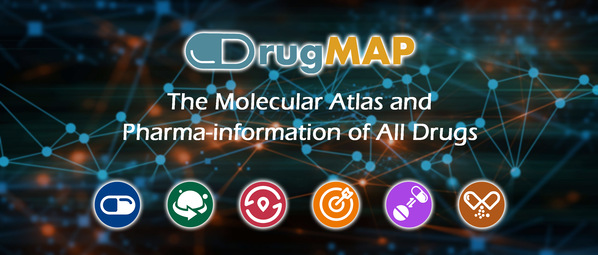Zhejiang University Experts Depict The Molecular Interaction Atlas Of All Drugs
The efficacy and safety of drugs are widely known as being determined by their interactions with multiple molecules of pharmacological importance such as transporters, metabolizing enzymes, targets and excipients. However, available pharmaceutical studies tend to focus on the specific type of interacting molecules, which lacks comprehensive descriptions of all molecules of pharmacological importance. In other words, the unilateral understanding of drug-molecule interaction atlas has severely limited the advances in novel drug discovery. Therefore, it is essential to systematically depict the molecular atlas of regulation mechanisms for each drug, which is expected to facilitate the design/repositioning of drugs.
On October 16 2022, Prof. ZHU Feng, Prof. ZENG Su from College of Pharmaceutical Sciences at Zhejiang University and Prof. CHEN Yuzong from College of Pharmaceutical Sciences at Tsinghua University collaborated to publish their research article entitled “DrugMAP: molecular atlas and pharma-information of all drugs” in the leading biomedical journal of Nucleic Acids Research, and constructed the world’s first knowledge base describing the molecular atlas and pharma-information of all drugs. The DrugMAP weaved the comprehensive & precise network containing >200,000 interactions among >30,000 drugs and >5,000 molecules. With the great efforts made to clarify the complex mechanism underlying drug pharmacokinetics and pharmacodynamics and rapidly emerging interests in AI-based network analyses, the drug-centric heterogeneous interaction networks provided in DrugMAP are considered to be the much-needed fundamental data for AI-based drug discovery.
The Interaction Pattern of the Drugs with Diverse Types of Molecules
As reported, the pharmacokinetic and pharmacodynamic characteristics of a drug are determined by its interactions with various molecules of pharmacological importance. Only by considering the holistic interaction pattern of the drugs with diverse types of molecules can we truly understand the regulation mechanisms of each drug. In this study, Prof. ZHU’s research team (a) validated over 40,000 drug-target interactions that play a dominant role in drug efficacy and resistance following a strict ‘target validation procedure’ well-established by previous publication (Nucleic Acids Res. 40, D1128-36, 2012), (b) identified over 6,000 drug-transporter and drug-metabolizing enzyme interactions that are critical in the drug ADME process based on the cellular or biochemical assays experimentally confirmed and reported in the literature, (c) systematically annotated and classified the inactive ingredients (DIGs) in the US FDA drug label, and collected over 20,000 drug formulations, and (d) corroborated ~130,000 clinically validated drug-drug interactions (DDI) that were induced by the coadministrations of therapeutics among 1,344 drugs approved or in clinical trial. The constructed DrugMAP further provides intuitive visualizations of the comprehensive interaction patterns, and all data can be freely accessed and downloaded.
The Expression Pattern of Drug-interacting Molecules among Different Sites
The drug-interacting molecules were frequently reported to be differentially expressed among different sites, which can significantly affect the efficacy and safety of drug: first, differential expression among disease sites has a profound impact on drug efficacy and the success of clinical trials; second, differential expression among ADME-related organs/tissues is key to explaining inter-individual variation in pharmacokinetics and predicting drug clearance; third, differential expression among other physiological sites is also essential to maintain the delicate balance between efficacy and safety. Thus, a precise and systematic description of the molecular atlas of the regulation mechanism for a drug asks for an explicit elucidation of the differential expression pattern of its interacting molecules. Accordingly, Prof. ZHU’s research team assessed and identified the differential expression pattern among (a) 108 disease sites of 21,781 patients, (b) 4 typical ADME-related organs (liver, colon, kidney, and small intestine) of 236 healthy individuals and (c) 32 physiological organs (prostate, breast, etc.) of 109 samples. The differential expression data of drug-interacting molecules were visualized in an intuitive and interactable way, which could be freely downloaded from DrugMAP.

